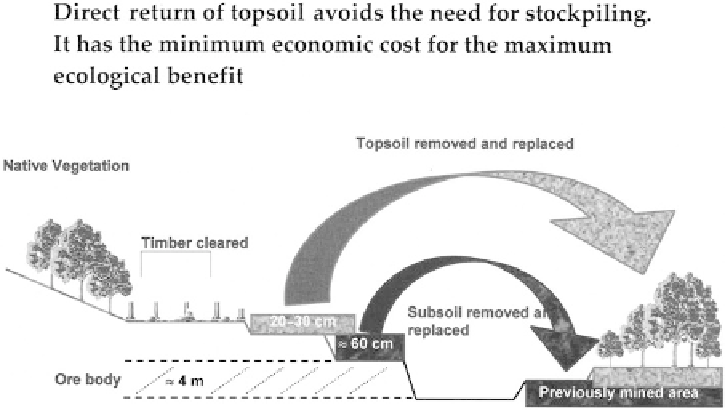Environmental Engineering Reference
In-Depth Information
Figure 15.3.
Direct return model for soil handling in mine site restoration schemes.
Ideally the topsoil and subsoil are placed directly onto the newly prepared landscape
(see text). If necessary, the soils are stockpiled only for a few hours or days at most.
This is the most effective manner of retaining soil fertility.
See colour plate section
.
prior to vegetative restoration (Hinz
1992
; Vlahos et al.
1999
; Koch
2007b
)
(
Fig. 15.3
). This process has become known as 'direct-return' soil handling
and provides the maximum ecological benefit for the smallest financial cost
on the ground.
Depending on the mine, before and/or after soil is spread on the new
landscape the mine floor is deep-ripped (subsoiled) in order to break up com-
pacted materials due to the nature of the regolith materials and the trafficking
of heavy machinery (
Fig. 15.4
) (Croton & Ainsworth
2007
; Kew et al.
2007
; Szota
et al.
2007
). The intention is to move a straight or winged tine (shown in
Fig. 15.4
) through the subsoil in order to create physical conditions more
amenable to root growth and penetration in the reconstructed soil profile
(Schaeffer et al.
2008
).
The diversity of the natural forest is typically high and therefore substantial
seed collection operations have to take place, normally exploiting locally
provenanced material representing over 100 plant species (Hinz
1992
; Vlahos
et al.
1999
; Koch
2007b
). Sowing may be by hand or mechanical seed spreader
and tends to take place during the dry season as the time of sowing has
little overall effect on seedling emergence of these well-adapted plant species
(
Fig. 15.5
) (Worthington et al.
2006
). Those species that do not take from seed are
propagated in nurseries and planted out by hand (Koch
2007a
).
After the soil and seed handling processes are complete, soil fertility is
addressed through chemical fertilisation. This is thought necessary in order

